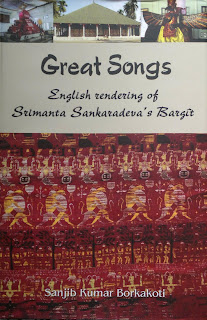Webinar series on Different facets of Sankaradeva Studies
A webinar series on Different facets of Sankaradeva Studies, organized by Society for Srimanta Sankaradeva was started with the maiden lecture programme by Dr Arshiya Sethi, dance scholar and Fulbright fellow from New Delhi on 19th December 2021. She talked on the theme “Going Global: Sankaradeva and the Living Arts of the Sattras.” The programme was moderated by Dr Sanjib Kumar Borkakoti, author and scholar of Sankari culture.
Dr Arshiya
Sethi referred to the
recognition of Sattriya dance in national level on 15th November, 2000 and
spoke about the challenges coming after that in her lecture. She gave special
reference to the devotees residing in the Sattras, the Vaishnav monasteries of
Assam. The recognition was accompanied by a change in its practising
population, a re-gendering of its performers, a change in its location, from
sacred to secular, as well as a change in its agenda and content, she said.
Flushed with new patronage since 2000, it has developed along diverted aesthetics, Dr Sethi said. However, in the context of the monasteries that produced and nurtured the dance, the receptivity was high. Thus, the first impetus of the global valorisation of Sankaradeva came from the living arts of the Sattras, particularly its dance called Sattriya. Whether in France, UK, USA, Mexico or New Zealand, audiences around the globe embraced its rarity and “authenticity”. This has kindled an interest in Sankardeva and his philosophy, Dr Sethi opined.
Dr Sanjib Kumar Borkakoti in his comment said that many aberrations have been seen in the aftermath of the new recognition by ill-trained performers. Over experimentation is also a menace as it will hurt the original features of the art form. It is the need of the hour to have a controlling body with tooth in order to prevent such distortions. The authenticity of the entire Sattriya culture would be at stake, he warned.
Among others Dr Ratul Chandra Bora, former Registrar of Mahapurusha Srimanta Sankaradeva Viswavidyalaya, Shilpika Bordoloi from Jorhat and Priyadarshini Dutta from USA gave their observations on the lecture. They highlighted the pressure coming on the performers in the wake of recognition of Sattriya as classical dance and stressed on preservation of the originality in the dance form. The role of academicians was also stressed upon. Mridu Moucham Bora, Secretary of Society for Srimanta Sankaradeva offered vote of thanks.
The second webinar in this series was held on 9th January, 2022. Geetha Sivangala Thandi, a Kuchipudi dance practitioner, California, USA delivered lecture on “Comparison between Sattriya dance and Kuchipudi dance”. It was moderated by Dr Sanjib Kumar Borkakoti.Geetha Sivangala Thandi
in her lecture compared two classical dance
forms of India, Kuchipudi and Sattrīyā,
belonging to Andhra and Assam regions, respectively. The context selected
was the enactment of the play Pārijāta
Haraṇa. It is performed as Śrī Kṛiṣṇa Pārijātaṁ in Kuchipudi
and Pārijāt Haraṇ in Sattrīyā. Comparison of the two
dance forms was done by her based on the eleven aspects of Nāṭya Śāstra, with special focus
on Caturvidha Abhinaya.
Comparison was also done on aspects such as story, script, and
characters. It was observed that though the thematic content is the same,
that is propitiation of lord Kṛiṣhṇa,
the approach taken in Kuchipudi is Madhura Bhakti and in Sattrīyā is Dāsya
Bhakti. The artistic expressions and treatment are diverse and
distinctly regional. Apart from spatial and temporal, the other reasons for
this distinction are observed to be socio-political and economic. The
popularity of these dance dramas is a pointer to the twin objectives of dance
dramas - spiritual awakening and entertainment.
Dr
Sanjib Kumar Borkakoti gave a brief idea about
both the dance forms in his introductory comments. Dr Borkakoti said
that there are some significant similarities between Sattriya dance and Kuchipudi dance. They both belong to
devotional genre. Earlier female roles were played by male dancers in both. But
there are also some differences like worship of Shakti in Kuchipudi dance, which is not seen in Sattriya dance.
Srimanta Sankaradeva created his own music for the dance form, which is not the
case in Kuchipudi dance. Dr Borkakoti said that there is necessity of
more such comparative study, specially from the practitioner with academic orientation.







-1.jpg)
Comments
Post a Comment
You are welcome to place your comment here :